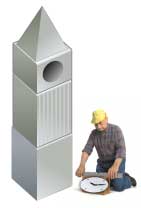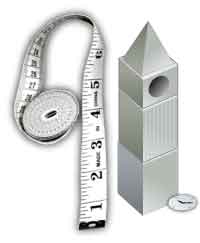These randomly scheduled missives will opine on a variety of topics, mostly intended to be germane to design, construction, capital program management, and other related issues. For shorter trips through the countryside, take a look at our blog, also called Notes from the Road. |
|
January 2011
First, let’s define some terms:
Close Your Mind — Briefly
Options
Many years ago, principals of Pacific Partners Consulting Group (PPCG) based in California presented very good papers on this subject to the Society for College and University Planning (SCUP) and the National Association of College and University Business Officers (NACUBO).
In their paper, they methodically graded the merits of each approach. We’ll save you, and cut to our view of the respective values:
We are often prodded to assign buildings a ‘Useful Life’, but in reality it is the individual components which age and become dysfunctional at different points in a building’s life. Some elements, such as moving parts, wear out rapidly. While others, like foundations, remain functional for long periods. It is therefore of little value, except as a convenience, to discuss the “Useful Life” of a building.  It is more appropriate to think of a building as an ongoing entity, with no defined life, assuming that components are replaced as they break. However, there is a point at which the user should have spent an amount equal to the replacement cost of the building. This can be considered a ‘Life’ of sorts; call it the ‘Financial Life’ or ‘Cost Accumulation Period’. It is more appropriate to think of a building as an ongoing entity, with no defined life, assuming that components are replaced as they break. However, there is a point at which the user should have spent an amount equal to the replacement cost of the building. This can be considered a ‘Life’ of sorts; call it the ‘Financial Life’ or ‘Cost Accumulation Period’.Note that the Financial Life calculated with the Sub-System Model can differ, sometimes significantly, from a standard or accounting life. It’s a consequence of taking into account the type, quality and details of the building. The budget recommendations for Capital Maintenance consequently differ from the other approaches. Now Budget — And Spend! Simply dividing the Capital Replacement Value by the number of years in the Financial Life provides the amount which should be set aside annually. This average annual amount represents the users’ true consumption of the building, and as a matter of equity, each year’s set of users should pay for their consumption, irrespective of whether the money is actually spent in any given year. Converting the Financial Life Calculation to a %CRV per year is also possible: %CRV per year = 1/Financial Life years  Voila — a %CRV that actually has backup. Use it. Voila — a %CRV that actually has backup. Use it.Stash the money away in a safe place. Then, when building systems require proper maintenance, the funds are there to do the work. Failure to make this set-aside, and spend it appropriately, is the principal cause of increasing Deferred Maintenance. The Ohio State Model - Updated Mort and I have arrived at a similar place to PPCG. However, we believe there is a better way to coordinate with common specification and cost estimating practices. We have found that Constructors and Construction Cost Estimators are typically entrenched with standard Construction Specifications Institute (CSI) categories. In the early 90’s, Ohio State University, in an attempt to refine its capital budgeting process, adopted a version of the Sub-System Model. By tweaking that approach into a CSI-consistent format, we can productively engage affiliated professionals into the process, producing more reliable and defensible Capital Replacement Value and component life estimates. In any event, variations of the Sub-System approach are possible; and are likely to be superior to other methods. Keep Your Hands Out Of The Cookie Jar! All four of the defined terms require needs-based budgets. Unfortunately, combining them has become commonplace. Consequently, it’s not unprecedented to see Capital Maintenance money used to fund Deferred Maintenance. Worse yet, some business managers have been known to pay for new construction from Capital Maintenance accounts, in complete opposition to the principles of recommended practice.  Sometimes, too, people with more brains than common sense will optimistically rationalize many Building Upgrades and functional updates as having offset components of Capital Maintenance. Often their conclusions are neither accurate nor wise. Too much manipulation makes for murky management. Sometimes, too, people with more brains than common sense will optimistically rationalize many Building Upgrades and functional updates as having offset components of Capital Maintenance. Often their conclusions are neither accurate nor wise. Too much manipulation makes for murky management.The fundamental principle: those who use the building should pay for it, year after year. Otherwise they are shifting the burden of bearing the cost to others. Discipline is a worthy trait. Miracles Are Possible! Perpetual life — forever useful. All it takes is sound money management. Remember — buildings, not people. Missed earlier newsletters? Find them here: |
|

 OK, not you — we’re gonna talk about your buildings here. I’ve personally accepted the fact that people are sadly mortal.
OK, not you — we’re gonna talk about your buildings here. I’ve personally accepted the fact that people are sadly mortal. Forget (for now) about three-quarters of the preceding. Routine Maintenance, Deferred Maintenance and Building Upgrades, while important, are not crucial to the message of this exercise. Planning for Capital Maintenance is the topic. Properly administering this important component of your facility's budget is crucial to perpetuating its life.
Forget (for now) about three-quarters of the preceding. Routine Maintenance, Deferred Maintenance and Building Upgrades, while important, are not crucial to the message of this exercise. Planning for Capital Maintenance is the topic. Properly administering this important component of your facility's budget is crucial to perpetuating its life. When used correctly, Plant Audits (usually called Facilities Condition Assessments or FCA’s) have good value for quantifying Deferred Maintenance, not projected Capital Maintenance. More thoughts about FCA’s can be reviewed in No Left Turn’s
When used correctly, Plant Audits (usually called Facilities Condition Assessments or FCA’s) have good value for quantifying Deferred Maintenance, not projected Capital Maintenance. More thoughts about FCA’s can be reviewed in No Left Turn’s  The bases admittedly may be crude. Estimated Capital Replacement Value is sometimes subjective (e.g., replacement in kind, or with budget construction), and the percent of CRV is the inverse of what some insist on calling ‘useful life’ (i.e., set aside 2.5% of CRV for buildings you deem to last 40 years).
The bases admittedly may be crude. Estimated Capital Replacement Value is sometimes subjective (e.g., replacement in kind, or with budget construction), and the percent of CRV is the inverse of what some insist on calling ‘useful life’ (i.e., set aside 2.5% of CRV for buildings you deem to last 40 years).